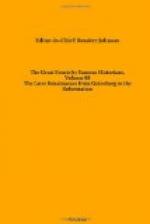But the time had not come; for without a very large demand, such as could not exist in those days, stereotyping would be of no advantage. Books which sell by hundreds of thousands, and are constantly reprinting, such as Bibles, prayer-books, school-books, Shakespeares, Bunyans, Robinson Crusoes, Uncle Toms, and very popular authors and editions, will pay for stereotyping; but for small numbers it is a loss. After the invention had been neglected long enough to be forgotten, Earl Stanhope, who had for several years devoted himself earnestly to the subject, and made many experiments, resuscitated it, in a very perfect manner, in 1803; and his printer, Mr. Wilson, sold the secret to both universities and to most of the leading printers. To the art of stereotyping the public is mainly indebted for cheap literature, for when the plates are once produced the chief expense is disposed of.
Something akin to stereotyping is another method of printing, called logography, invented by John Walter of the London Times, in 1783, and for which he took out a patent. This means a system of printing from type cast in words instead of single letters, which it was thought would save time and corrections when applied to newspapers, but it was not found to answer. A joke of the time was a supposed order to the type-founder for some words of frequent occurrence, which ran thus: “Please send me a hundredweight, sorted, of murder, fire, dreadful robbery, atrocious outrage, fearful calamity, alarming explosion, melancholy accident; an assortment of honourable member, whig, tory, hot, cold, wet, dry; half a hundred weight, made up in pounds, of butter, cheese, beef, mutton, tripe, mustard, soap, rain, etc., and a few devils, angels, women, groans, hisses, etc.” This method of printing did not succeed; for if twenty-four letters will give six hundred sextillions of combinations, no printing-office could keep a sufficient assortment of even popular words.
[Footnote 1: See Vol 1, 8]
[Footnote 2: See accompanying fac-simile of a page of the English edition—a reproduction as faithful as possible in text, color, texture of paper, etc.]
JOHN HUNYADY REPULSES THE TURKS[1]
A.D. 1440-1456
ARMINIUS VAMBERY
From the time (1354) when the Turks took Gallipoli and secured their first dominion in Europe, the Ottoman power on that side of the Hellespont was gradually increased. In 1360 Amurath I crossed from Asia Minor, ravaged an extensive district, and took Adrianople, which he made the first seat of his royalty and the first shrine of Mahometanism in Europe. He next turned toward Bulgaria and Servia, where in the warlike Slavonic tribes he found far stronger foes than the Greek victims of earlier Turkish conquests.




